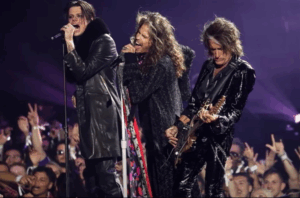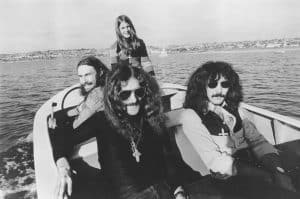These ’80s Classics Have Backstories Crazier Than the Songs Themselves

via journey / YouTube
Some hit songs are born from heartbreak. Others pop out of random late-night experimenting. And then there are those with origin stories so strange that once someone learns them, the song never sounds the same again. The ’80s produced more than a few of these musical oddities — songs with roots far wilder than their polished radio versions suggest.
Sure, plenty of tracks take years to write, shaped slowly and patiently, the way Queen spent ages fine-tuning “Bohemian Rhapsody.” Others fall out of the sky in minutes, almost fully formed. But sometimes the most fascinating part of a song isn’t how long it took to write — it’s why it was written at all.
Take the light, bouncy “Love Song” that Sara Bareilles released in 2007. People assumed it was a sweet little piano tune — until she explained it was a cheeky protest against the music industry pressuring her to write something “more commercial.” And long before that, R.E.M. released “Shiny Happy People,” a song that even its creators poked fun at because it was way cheesier than anything they normally did. These backstories show how different the truth can be from what listeners imagine. But a few songs from the 1980s have backstories so strange, dramatic, or downright haunting that they deserve special attention.
Bonnie Tyler’s “Total Eclipse of the Heart” Was Originally Written for a Vampire Musical
It’s easy to picture “Total Eclipse of the Heart” as a giant, emotional power ballad — because that’s exactly what it is. But most listeners have no idea that its original purpose was even more dramatic. The song was first imagined as part of a musical about Nosferatu, the eerie vampire figure inspired by Dracula. Suddenly, that wild, gothic music video with swirling curtains, glowing eyes, and mysterious figures makes perfect sense.
The song came from the mind of Jim Steinman, a writer known for creating songs that sound like they belong on a theater stage. He’s the same person who wrote epic, over-the-top hits for Meat Loaf, Celine Dion, and Bonnie Tyler herself. His music has a signature style: giant emotions, booming drama, and enough flair to fill an opera house.
Steinman had been developing theatrical music since the late ’60s, and pieces of “Total Eclipse of the Heart” actually trace back to one of his early stage projects. When Bonnie Tyler heard Meat Loaf performing Steinman’s work, she immediately wanted to collaborate with him. At first he wasn’t sure — until he heard her voice. Her raspy, powerful sound convinced him the song belonged to her. And even though the musical it was meant for never materialized, the haunting, romantic, oddly spooky energy stayed baked into every second of the track.
Metallica’s “One” Comes Straight From a Terrifying War Novel
Metallica’s “One,” released in 1988, is one of the band’s darkest and most emotional songs. Even today, it’s hard to listen to without feeling unsettled. The track tells the story of a soldier who survives an explosion but loses his limbs and senses, becoming trapped in a body that no longer connects him to the world. The intensity builds until the music practically sounds like a battlefield.
Some listeners originally misunderstood the song or simply took it as a general anti-war statement. But the story actually comes from a novel published in 1939 called Johnny Got His Gun. Metallica’s singer, James Hetfield, read the book and was struck by the sheer terror of its plot. The novel was also made into a film, and the band ended up using footage from that movie in their music video.
This wasn’t Metallica’s first time writing songs influenced by classic literature or war. They had already pulled ideas from Ernest Hemingway and had written other tracks about soldiers used as disposable tools. But “One” stood out because it was so specific — a direct translation of a single character’s nightmare into sound. The horror didn’t come from fantasy but from the real conflicts and injuries that inspired the book decades earlier.
Phil Collins’ “In the Air Tonight” Isn’t About a Murder — It’s Just About Divorce
No ’80s song carries more mysterious energy than Phil Collins’ “In the Air Tonight.” The slow build, the echoing vocals, and of course, the explosive drum moment, all helped fuel one of music’s most famous urban legends. For years, people whispered that the song was inspired by a drowning, a crime Collins supposedly witnessed, and that he later confronted the guilty person at a concert. The story spread so widely that even other artists referenced it. But none of it was true.
Collins eventually cleared things up in a TV interview. The real inspiration behind “In the Air Tonight” was far less dramatic in a detective-story sense but deeply emotional on a personal level: he was going through a painful divorce. The anger, frustration, and confusion he felt at the time spilled into the song. That’s why the lyrics have a raw, almost confrontational tone, even though they’re not aimed at a mysterious criminal. They came from a man trying to process the collapse of his marriage. And the famous drum break? That wasn’t planned as some grand symbolic moment. It just happened to be the perfect musical release for everything he was feeling.
These stories show that the ’80s weren’t just about big hair and synthesizers. Behind some of the decade’s most unforgettable songs were ideas pulled from vampire scripts, anti-war novels, and emotional personal battles — proof that great music often hides fascinating secrets waiting to be uncovered.















